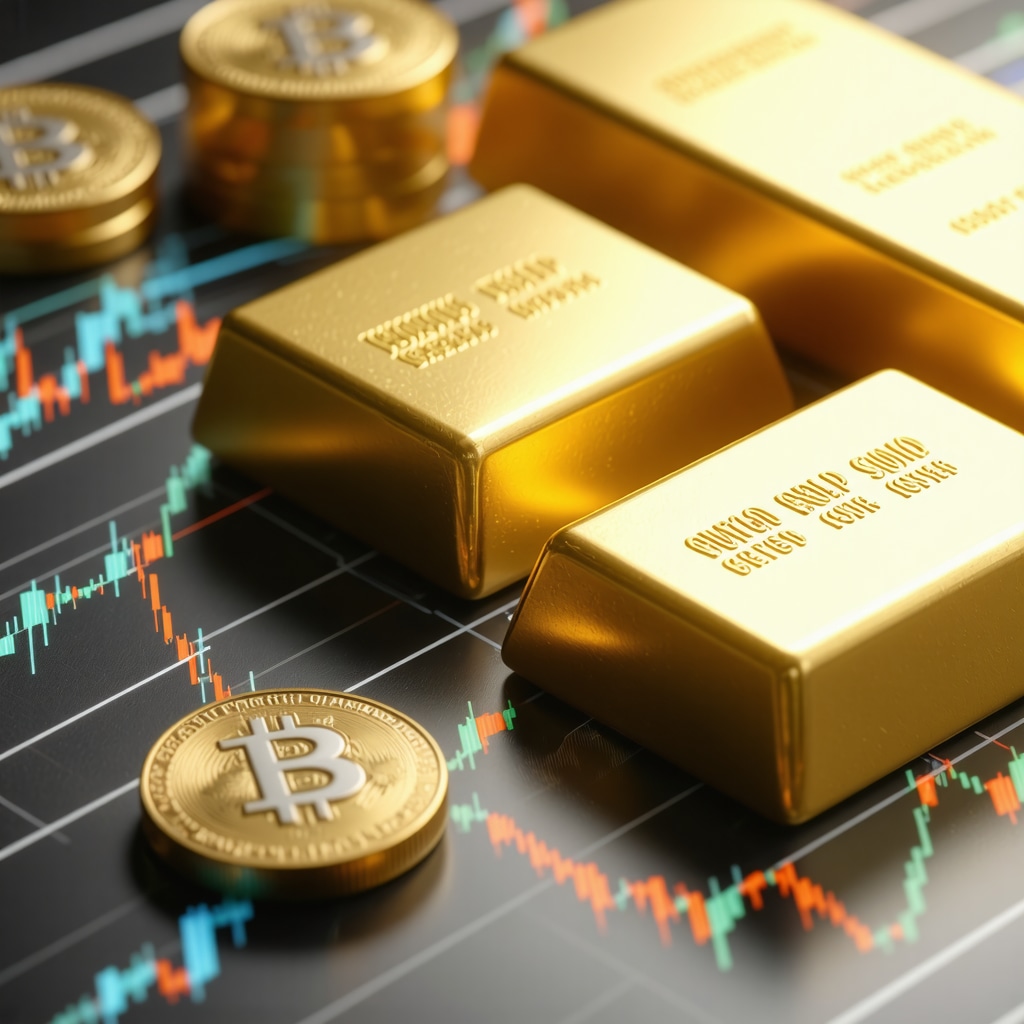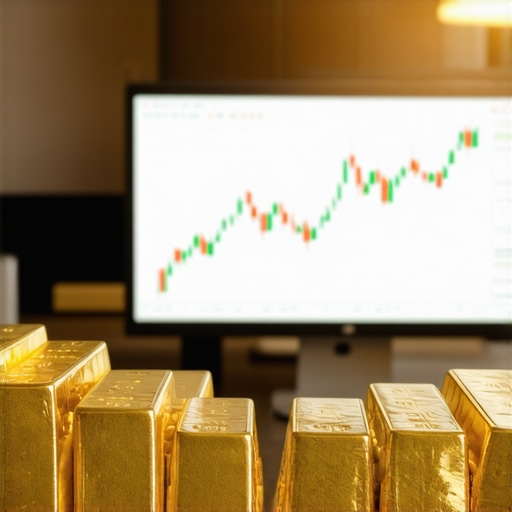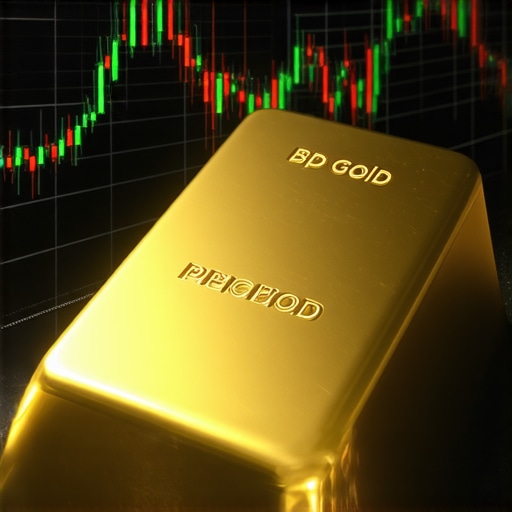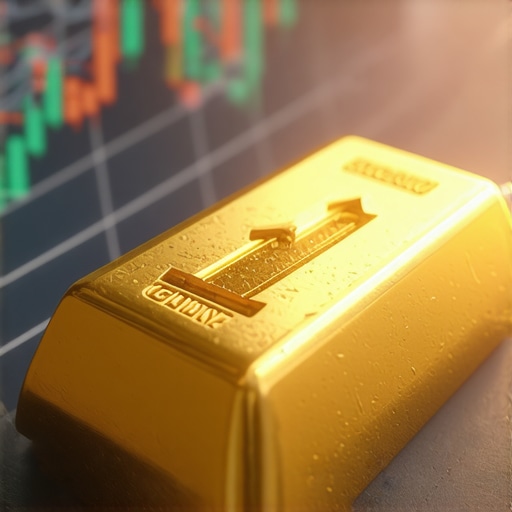Unlocking the Future: What Drives Gold Prices Towards 2026?
As global economic dynamics evolve, understanding the trajectory of gold prices by 2026 is paramount for investors seeking to safeguard and grow their portfolios. Gold, historically revered as a haven during financial turmoil, now faces a complex interplay of geopolitical tensions, inflationary pressures, and shifting central bank policies that will sculpt its future valuation.
Beyond the Surface: Deep-Rooted Factors Impacting Gold’s 2026 Valuation
Gold’s price is not merely a reflection of supply and demand; it intertwines with macroeconomic signals such as real interest rates, currency fluctuations, and emerging market demand. For instance, central banks globally are increasing their gold reserves as a hedge against currency depreciation, a trend that could significantly bolster prices. Meanwhile, the ongoing inflation concerns in major economies are driving investors towards gold’s intrinsic value as a safeguard.
How Will Emerging Technologies and Market Innovations Influence Gold Investment Strategies?
Technological advancements, including blockchain-based gold trading platforms and tokenized gold assets, are revolutionizing how investors access and trade gold. These innovations promise enhanced liquidity and transparency, enabling both retail and institutional investors to navigate the gold market with greater efficiency. Staying ahead means embracing these tools to optimize entry and exit points in anticipation of 2026 market conditions.
Expert Take: Integrating Gold Into a Diversified Portfolio for 2026
Seasoned investors recommend a balanced approach that combines physical gold, gold ETFs, and gold mining stocks to harness diversified exposure. This strategy mitigates risks associated with market volatility while capitalizing on gold’s potential upside. For those new to gold investment, resources like the beginner’s guide to physical gold offer practical steps to enter the market confidently.
Reading the Signs: What Global Economic Indicators Should Investors Monitor?
To anticipate gold price movements, investors should closely watch indicators such as U.S. Federal Reserve interest rate policies, inflation data, and geopolitical risks. The International Monetary Fund (IMF) reports highlight how currency devaluations and trade uncertainties often precipitate increased gold demand. Staying informed through authoritative sources equips investors to make timely, informed decisions.
Building Resilience: Preparing Your Investment Strategy for Gold Price Fluctuations
Volatility is inherent in commodity markets, and gold is no exception. Developing a strategy that accounts for potential price swings while leveraging gold’s role as a hedge against inflation and market downturns is crucial. Investors might find it beneficial to explore best gold investment strategies to hedge inflation for nuanced tactics tailored to current trends.
Curious about how these forecasts align with evolving market realities? Share your thoughts or questions below to join a community of informed investors navigating gold’s promising future.
For a comprehensive understanding of the factors shaping gold prices, consult the World Gold Council’s latest market insights here.
Deconstructing Central Bank Influence: The Silent Force Behind Gold Price Stability
Central banks have long been pivotal in shaping the gold market’s supply-demand equilibrium. Their strategic accumulation or liquidation of gold reserves sends ripples across global markets, impacting prices significantly. In recent years, an accelerated pace of gold purchases by emerging market central banks, particularly in Asia, has underscored a deliberate move to diversify reserves away from traditional fiat currencies. This trend not only stabilizes gold prices but also signals investor confidence in gold as a long-term store of value amid geopolitical uncertainties.
Moreover, central bank policies regarding interest rates and monetary easing remain tightly correlated with gold valuations. Lower real interest rates reduce the opportunity cost of holding non-yielding assets like gold, thereby enhancing its appeal. Understanding these monetary policy shifts is critical for anticipating gold price trajectories heading into 2026.
Gold Market Sentiment and Behavioral Finance: Decoding Investor Psychology
Beyond fundamental drivers, the psychology of market participants plays a crucial role in gold’s price fluctuations. Sentiment indices, such as the Gold Investor Sentiment Index, offer valuable insights into collective investor moods—fear, greed, or uncertainty—that often precede price movements. For example, during periods of heightened geopolitical tension or economic downturns, a surge in safe-haven buying can propel gold prices upward rapidly.
Seasoned investors leverage these behavioral cues alongside quantitative data to fine-tune entry and exit points. This hybrid approach combines the rigor of technical analysis with an understanding of market psychology, providing a comprehensive framework for navigating volatility.
What Role Will ESG and Sustainable Practices Play in Shaping Gold Investment Trends?
Environmental, Social, and Governance (ESG) criteria are increasingly influencing investor decisions across asset classes, and gold is no exception. Mining companies that prioritize sustainable practices and ethical sourcing are gaining favor among institutional investors who integrate ESG considerations into their portfolios. This shift not only affects stock valuations of gold producers but also shapes the overall investment landscape by encouraging transparency and responsibility.
Furthermore, innovations such as blockchain-based traceability systems are enhancing the accountability of gold supply chains, reassuring investors about the provenance and ethical compliance of their holdings. Aligning with these ESG trends can offer investors a dual benefit: contributing to sustainable development while potentially capturing premium valuations for responsible gold assets.
For a detailed exploration of ESG factors shaping gold investments, consult MSCI’s ESG Investing Resources, a leading authority on sustainable finance.
Integrating Gold With Alternative Asset Classes: Strategies for Portfolio Resilience
Given gold’s unique risk-return profile, experts advocate for its inclusion alongside alternative assets like cryptocurrencies and real estate to enhance diversification. While gold traditionally serves as a hedge against inflation and currency risk, pairing it with high-growth assets can balance portfolio volatility and optimize long-term returns.
Strategically timed allocations to gold ETFs or mining stocks can complement exposure to other asset classes, providing liquidity and potential capital appreciation. Investors should consider dynamic portfolio rebalancing to adapt to shifting macroeconomic landscapes, ensuring that gold’s defensive qualities are leveraged effectively without compromising growth objectives.
To deepen your understanding of gold’s role relative to other investments, explore our comprehensive analysis on gold versus stocks in crisis scenarios.
Geopolitical Risk Cascades: Unraveling Their Complex Impact on Gold Prices by 2026
Geopolitical tensions have historically acted as catalysts for significant gold price movements. However, the evolving global landscape introduces nuanced risk layers that demand a sophisticated understanding to forecast gold’s trajectory accurately. From escalating trade disputes to regional conflicts and sanctions regimes, these factors collectively amplify uncertainty, often driving a flight-to-safety demand for gold.
Unlike past decades where singular events dictated market sentiment, the current era features overlapping crises—such as the ongoing Russia-Ukraine conflict combined with strained US-China relations—that create persistent volatility. This multidimensional risk environment tends to increase gold’s appeal as a non-yielding asset with intrinsic value, particularly when conventional financial instruments are perceived as vulnerable.
Moreover, the interplay between geopolitical risk and currency markets is critical. For instance, a weakening U.S. dollar amidst global instability typically reinforces gold’s dollar-denominated price, attracting international buyers seeking currency diversification. Investors must therefore monitor geopolitical developments not in isolation but as part of a larger systemic risk framework influencing gold demand and pricing dynamics.
Monetary Policy Divergence: How Central Banks’ Contrasting Strategies Shape Gold’s Path
As 2026 approaches, an increasingly divergent global monetary policy landscape is emerging, adding complexity to gold price forecasts. While some central banks pursue tightening cycles to combat inflation, others maintain accommodative stances to support economic recovery. This divergence creates differential impacts on real interest rates, a pivotal driver of gold’s appeal.
Lower real yields diminish opportunity costs for holding gold, boosting demand, whereas rising real yields tend to pressure gold prices downward. For example, the U.S. Federal Reserve’s trajectory towards higher rates contrasts with the European Central Bank’s more cautious approach, creating asymmetric effects across global markets.
Additionally, unconventional policies like quantitative easing and yield curve control, still employed by select central banks, sustain liquidity and can indirectly underpin gold prices by mitigating financial market stress. Investors aiming to anticipate gold’s movements must incorporate detailed analyses of these policy nuances, recognizing that monetary policy is no longer a monolithic force but a mosaic influencing gold through multiple channels simultaneously.
What Advanced Analytical Models Best Capture the Interaction Between Macro Variables and Gold Prices?
Forecasting gold prices amidst multifaceted economic indicators requires sophisticated econometric and machine learning models that can parse nonlinear relationships and latent factors. Vector autoregression (VAR) models, for example, allow simultaneous examination of feedback loops between gold prices, inflation expectations, real interest rates, and geopolitical risk indices.
More recently, ensemble machine learning techniques, such as random forests and gradient boosting, have been utilized to improve predictive accuracy by integrating high-dimensional datasets including sentiment analysis from news streams and social media, central bank balance sheets, and currency volatility metrics.
These models provide investors with probabilistic forecasts rather than deterministic outcomes, enabling more nuanced risk management. For practitioners, integrating such advanced analytics with domain expertise offers a strategic edge in navigating the intricate gold market landscape approaching 2026.
For further exploration of modeling techniques applied to gold price forecasting, see the detailed research by the National Bureau of Economic Research on commodity price dynamics.
Strategic Positioning: Enhancing Portfolio Resilience Amid Gold Market Complexities
Given the increasingly intricate drivers of gold prices, constructing resilient portfolios necessitates dynamic strategies that capitalize on gold’s hedging properties while accommodating volatility. Tactical allocation adjustments based on macroeconomic scenario analyses can optimize risk-adjusted returns.
Investors are encouraged to employ multi-asset risk models incorporating gold’s correlations with equities, bonds, and emerging assets such as cryptocurrencies. This approach facilitates identifying regime shifts where gold’s protective qualities become more pronounced, such as during stagflationary periods or systemic financial stress.
Furthermore, diversification across gold investment vehicles—including physical bullion, ETFs with liquidity advantages, and select mining equities with exposure to sustainable operations—can reduce idiosyncratic risks. Active monitoring of geopolitical developments and monetary policy updates is essential to timely rebalancing.
Engage with our expert analyses and tools to refine your gold investment strategy as 2026 approaches, ensuring your portfolio remains robust against emerging economic and geopolitical uncertainties.
Discover more about sophisticated gold investment strategies and market insights on BuyingOldNow’s expert resource hub.
Harnessing Macroeconomic Synergies: Integrative Approaches to Gold Price Dynamics
In the multifaceted arena of gold price forecasting, isolated economic indicators often fail to capture the full spectrum of influencing factors. Sophisticated investors increasingly adopt integrative frameworks that synthesize monetary policy shifts, geopolitical risk assessments, and behavioral finance insights to derive holistic market perspectives. This synergistic approach enables anticipation of price inflection points that traditional linear analyses might overlook, particularly as 2026 approaches amid unprecedented global economic complexities.
Quantitative Sentiment Analysis: Leveraging Market Psychology for Tactical Advantage
Beyond fundamental metrics, the quantification of investor sentiment through natural language processing (NLP) of financial news and social media platforms offers a cutting-edge lens into gold market psychology. By tracking sentiment momentum and volatility indices in real time, advanced analytics can identify herd behavior triggers and contrarian signals. This granular insight empowers portfolio managers to optimize timing for gold acquisition or divestment, enhancing return profiles while mitigating downside risks associated with sudden market sentiment shifts.
How Can Advanced Econometric and Machine Learning Models Be Calibrated to Capture Real-Time Gold Market Volatility?
Calibration of predictive models to real-time data streams requires adaptive algorithms that incorporate regime-switching capabilities and volatility clustering phenomena inherent in commodity markets. Techniques such as Hidden Markov Models (HMM) combined with recurrent neural networks (RNN) enable dynamic adjustment to evolving market conditions by detecting latent state transitions in gold price behavior. Furthermore, integrating exogenous variables like geopolitical event indices and central bank announcements refines model responsiveness, facilitating nuanced scenario forecasting and risk quantification.
For practitioners interested in the forefront of such methodologies, the National Bureau of Economic Research’s comprehensive study on commodity price dynamics offers an authoritative deep dive into these avant-garde approaches.
Strategic Hedging and Dynamic Allocation: Pioneering Portfolio Resilience
As market volatility intensifies, embedding dynamic hedging instruments—such as gold futures and options—within portfolio structures becomes paramount. These derivatives provide tailored exposure to gold’s price movements, enabling precise risk management and the exploitation of short-term market dislocations. Coupled with algorithmic rebalancing strategies that respond to macroeconomic indicator thresholds, investors can sustain optimal asset allocations that harmonize growth ambitions with capital preservation imperatives.
Moreover, embracing a multi-faceted gold investment spectrum—from physical bullion to ESG-compliant mining equities—strengthens resilience against sector-specific shocks and regulatory shifts. This diversity, aligned with forward-looking macroeconomic models, cultivates a robust defense against the complex interplay of risks shaping gold’s trajectory.
Engage with our expert analyses and leverage cutting-edge strategies to fortify your investment portfolio ahead of 2026. Explore more at BuyingOldNow’s expert resource hub and position yourself at the vanguard of gold investment excellence.
Frequently Asked Questions (FAQ)
What key factors will most influence gold prices by 2026?
Gold prices in 2026 will be shaped by a complex interplay of global monetary policies, real interest rates, geopolitical tensions, inflation expectations, central bank reserve activities, and investor sentiment. Emerging technologies like blockchain and ESG considerations also increasingly impact demand and valuation.
How do central bank policies affect gold price stability?
Central banks influence gold prices through their reserve management—accumulating or liquidating gold—and through monetary policy decisions affecting real interest rates. Lower real yields reduce the cost of holding gold, boosting demand, while tightening monetary policies can pressure prices downward. Divergent global monetary strategies add complexity to price forecasts.
Can technological innovations change how investors access gold?
Yes, blockchain-based trading platforms and tokenized gold assets enhance liquidity, transparency, and accessibility for both retail and institutional investors. These innovations enable more efficient entry and exit strategies, broadening participation and potentially stabilizing market dynamics.
What role does investor psychology play in gold price movements?
Investor sentiment, often driven by fear, greed, or uncertainty, can precipitate rapid gold price shifts. Behavioral finance tools and sentiment indices help anticipate these movements, allowing investors to time trades better by combining technical data with psychological insights.
How important is ESG compliance in gold investments?
Environmental, Social, and Governance (ESG) criteria are increasingly critical, influencing investor preferences for ethically sourced gold and sustainable mining operations. ESG compliance can enhance valuations and attract institutional capital while promoting transparency and responsible supply chains.
What strategies can enhance portfolio resilience using gold?
Experts recommend diversifying gold exposure across physical bullion, ETFs, and mining stocks, integrating hedging instruments like futures and options, and dynamically allocating based on macroeconomic and geopolitical signals. Combining gold with alternative assets such as cryptocurrencies and real estate further optimizes risk-adjusted returns.
How do geopolitical risks impact gold prices?
Geopolitical tensions increase uncertainty, often triggering flight-to-safety buying that elevates gold prices. The multifaceted nature of current global risks—such as conflicts and trade disputes—creates persistent demand for gold as a non-yielding, stable asset amid currency volatility.
Which analytical models best forecast gold price dynamics?
Advanced econometric models like vector autoregression (VAR), and machine learning techniques including random forests and neural networks, capture nonlinear relationships among macroeconomic variables, sentiment, and geopolitical data. These probabilistic models improve forecast accuracy and risk management.
How should investors monitor economic indicators related to gold?
Key indicators include U.S. Federal Reserve interest rate decisions, inflation data, currency exchange rates, central bank reserve changes, and geopolitical event indices. Staying informed through authoritative sources enables timely adjustments to gold investment strategies.
Is gold still a good hedge against inflation in 2026?
Yes, gold’s intrinsic value and historical performance during inflationary periods continue to support its role as a hedge. Coupled with strategic portfolio allocation and market timing, gold can effectively preserve purchasing power amid rising prices.
Trusted External Sources
- World Gold Council (WGC): Provides comprehensive research on global gold demand, supply trends, and investment insights essential for understanding gold market fundamentals.
- International Monetary Fund (IMF): Offers authoritative reports on global economic indicators, currency stability, and central bank reserve policies that directly influence gold prices.
- National Bureau of Economic Research (NBER): Publishes advanced econometric studies and commodity price dynamics research, including machine learning approaches to gold price forecasting.
- MSCI ESG Research: Delivers critical analysis on Environmental, Social, and Governance factors affecting gold mining companies and sustainable investment trends.
- Federal Reserve Economic Data (FRED): Supplies up-to-date data on interest rates, inflation, and monetary policies crucial for macroeconomic analysis impacting gold.
Conclusion
Forecasting gold prices towards 2026 demands an integrative understanding of multifaceted economic, geopolitical, technological, and behavioral factors. Central bank actions, inflation trajectories, investor sentiment, and sustainable investment trends collectively sculpt gold’s valuation landscape. Advanced analytical models and dynamic portfolio strategies empower investors to navigate volatility and harness gold’s defensive and growth potential effectively. By leveraging diversified gold investment vehicles and embracing emerging innovations, investors can position themselves to capitalize on gold’s enduring role as a strategic asset.
Equip yourself with this expert knowledge, engage with authoritative market insights, and refine your investment approach to unlock gold’s promising future. Share your perspectives or explore related expert content to join a community at the forefront of gold investment excellence.











The insight into how central banks’ increasing gold reserves will influence prices by 2026 really stood out to me. It’s fascinating how these institutions act almost like unseen market forces, stabilizing gold prices amid global uncertainties. I’ve noticed that in recent years, especially with rising inflation and geopolitical tensions, many investors are turning to gold not just as a physical asset but also via technological innovations like tokenized gold. This shift offers enhanced liquidity while still preserving gold’s hedge qualities.
One thing I’m curious about is how the integration of ESG criteria will impact gold mining stocks specifically. While sustainability is gaining traction in many investment sectors, balancing profitability and responsible mining practices seems challenging. Have others observed whether prioritizing ESG factors in gold investments tends to impact returns positively over time, or is it still too early to tell? Also, with emerging blockchain-based trading platforms improving transparency, does this technological angle effectively assure investors about ethical sourcing?
For those balancing portfolio diversification with gold, how do you weigh the traditional appeal of physical gold against these newer digital access points? I’m keen to hear about different strategies, especially from investors who have adapted dynamically in response to these evolving market complexities as we approach 2026.
Rebecca, your points about the intersection of ESG criteria and technological innovations in gold investing really resonate. From what I’ve observed, incorporating ESG factors into gold mining stocks often involves a delicate balancing act. While some mining companies that emphasize sustainability have faced higher upfront costs, they tend to benefit from improved operational efficiencies and reputational capital in the long term. This can translate into more stable returns and attract institutional investors increasingly focused on responsible investing.
Regarding blockchain’s role in assuring ethical sourcing, I agree it offers a promising path toward greater transparency. By enabling traceability through the supply chain, blockchain can help verify the origin of gold and compliance with environmental and social standards. However, the challenge remains in achieving widespread adoption across all players, from producers to distributors.
On the portfolio diversification front, I perceive physical gold as a tangible hedge, especially during extreme market stress, while tokenized gold provides agility and ease of trading that traditional physical assets can’t match. Combining both can allow investors to benefit from liquidity without sacrificing the safety net that physical gold provides.
I’m curious—how have others balanced these trade-offs between traditional physical holdings and emerging digital formats in their strategies? Has anyone experienced scenarios where tokenized assets provided an unexpected advantage or drawback?